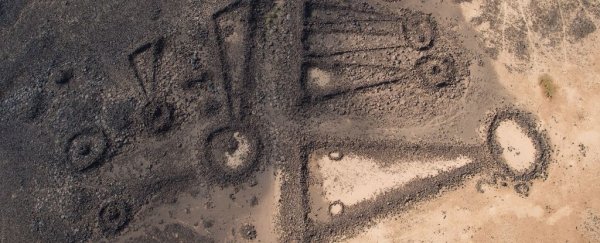The road to life in the Arabian desert might once have been paved with the dead.
In what is now Saudi Arabia, archaeologists have revealed an impressive network of lost highways, marked by human tombs, that link one oasis to another.
Many thousands of years ago, these roads would have led Bedouin people and their animals to water, guided via avenues of their ancestors.
"Funerary avenues were the major highway networks of their day, and show that the populations living in the Arabian Peninsula 4,500 years ago were far more socially and economically connected to one another than we previously thought," says archaeologist Matthew Dalton from the University of Western Australia.
Stone-lined burial chambers like the ones found in Saudi Arabia are quite common throughout the Arabian Peninsula, but in northwest Arabia they are far more concentrated.
Over the past decade, satellite imagery has revealed a region dotted with thousands of pendant-like stone structures, either flanking ancient roads in the desert or pointing towards them.
The below image compares both arrangements side by side.
To the left, you can see a series of ringed stone mounds and tailed 'pendant' structures bordering an ancient path.
To the right is a more sparse terrain, dotted by various types of pendant structures, all of which run parallel to a series of roads in between, which lead to a water source.
 (AAKSAU/AAKSAK and Royal Commission for AlUla)
(AAKSAU/AAKSAK and Royal Commission for AlUla)
The closer a road gets to an oasis, the more concentrated the surrounding structures become.
Using satellite imagery and on-the-ground investigations, archaeologists working in Saudi Arabia identified an "incredible density of prehistoric funerary monuments" with "no equivalent elsewhere".
In one county alone, known as Khaybar, researchers counted nearly 10,000 drystone funerary structures, and most of these were located near permanent water sources.
"These oases, especially Khaybar, exhibit some of the densest concentrations of funerary monuments known worldwide," says Dalton.
"The sheer number of Bronze Age tombs built around them suggests that populations had already begun to settle more permanently in these favorable locations at this time."
Below is an example at the al Ha'it Oasis.
 (AAKSAU/AAKSAK and Royal Commission for AlUla)
(AAKSAU/AAKSAK and Royal Commission for AlUla)
When examining individual oases closer, researchers identified a web of smaller pathways radiating outwards. They suspect these were probably used to move herds of animals in seasons when rainfall was higher.
During drought, however, the longer-range roads were probably more useful. By bouncing from one oasis or desert spring to another, ancient Bedouins could traverse much larger areas in search for better lands and climates.
"Indeed, by following only the networks of identified funerary avenues, it would be possible to traverse some 530 kilometers," the authors write.
All thanks to the generations before.
The study was published in The Holocene.
